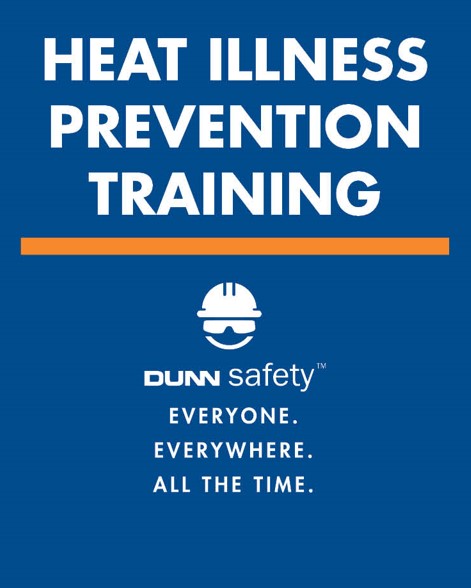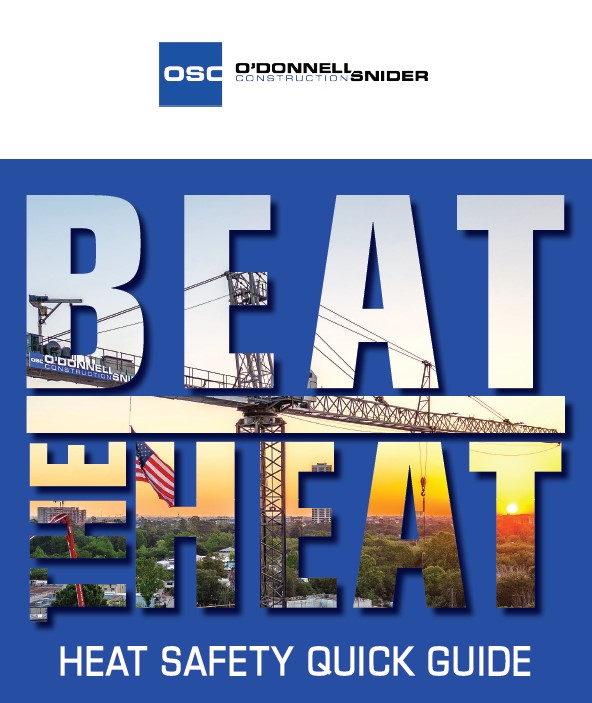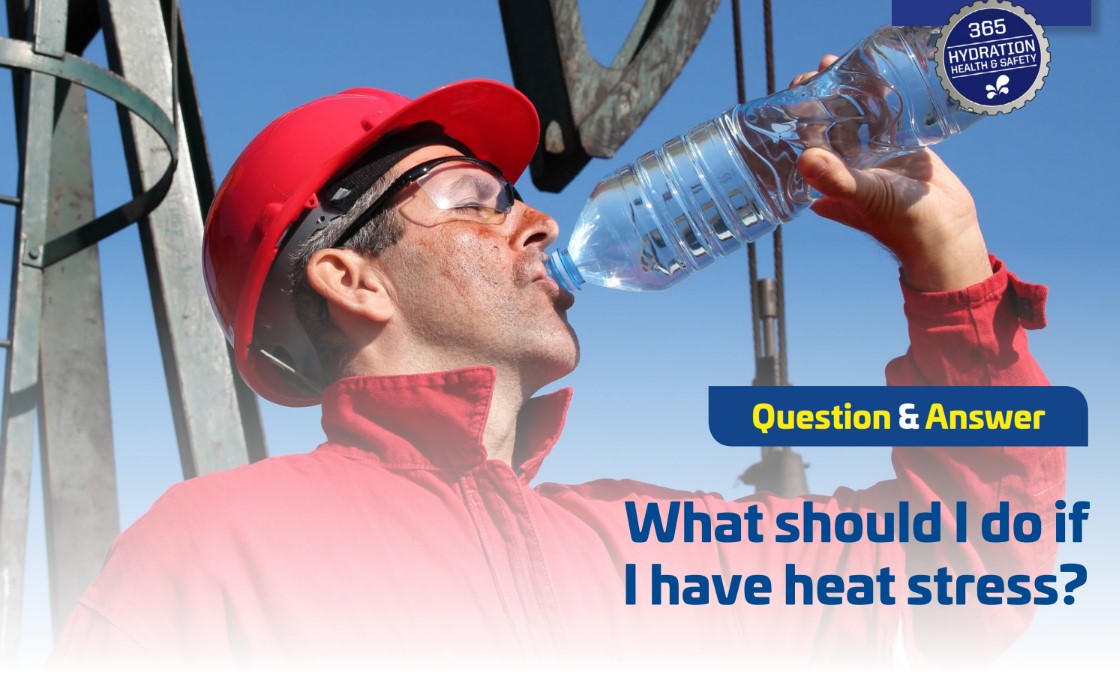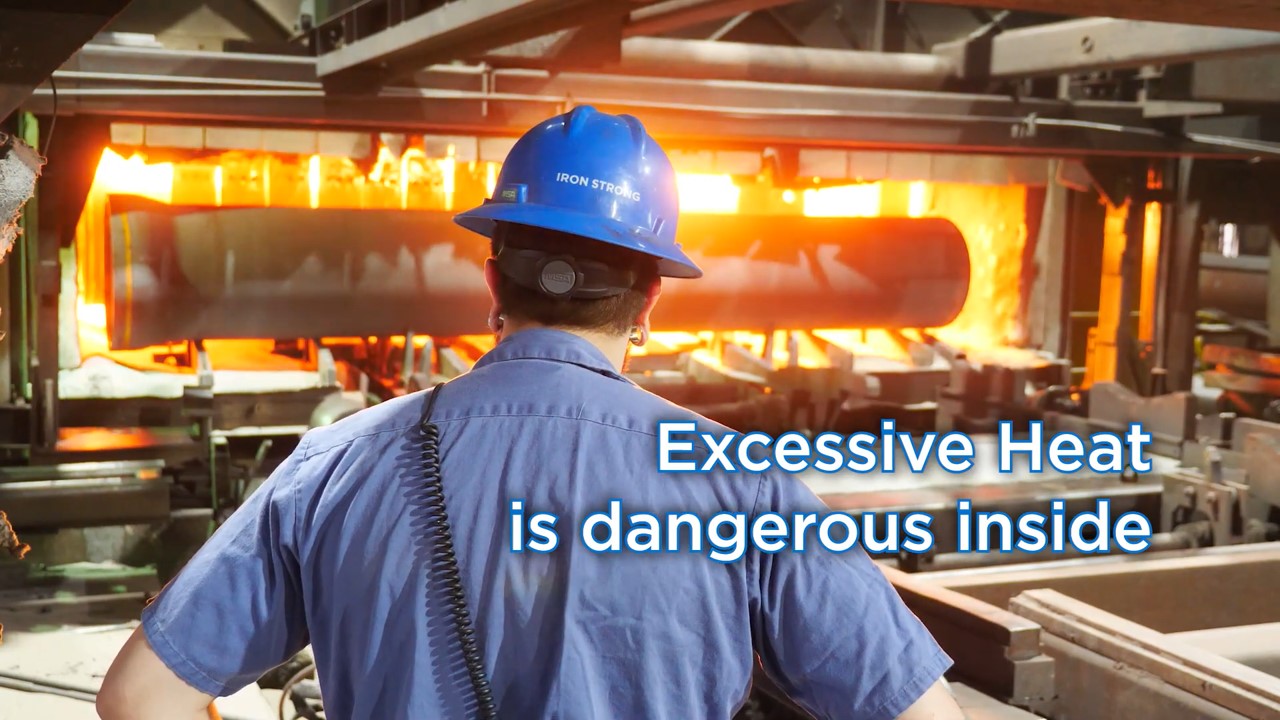Heat Illness Prevention
 Beat the Heat National Contest - OSHA
Beat the Heat National Contest - OSHA
In 2024, OSHA sponsored the 'Beat the Heat' contest to raise awareness of the dangers and hazards of heat exposure in both indoor and outdoor workplaces. This year, OSHA sponsored the 'Beat the Heat' photo contest. This photo contest challenged stakeholders to capture an image of how to work safely in the heat and share it with OSHA. The photos highlight effective strategies to keep workplaces safe from the heat.
This year's contest winners are:
The photo from Alberici Constructors, Inc. highlights a hydration station area at an outdoor worksite. Workers not only have access to cool water, but they also have a place to sit and rest in the shade. Posters and pamphlets are posted at the hydration station to encourage healthy hydration habits and staying safe from the heat.

In this photo, the CGI workers are taking a rest break and snacking on cold oranges. The crew is wearing company provided cooling vests, hardhat sunshields, and cooling hardhat head liners, which help keep the crew cool throughout their shift outdoors. The cooling stations have ice chests with bottled water, electrolyte packets, ice pops, oranges, and the company job box (which includes a first aid kit, fire extinguisher, the Safety Data Sheets book, ear plugs, and N95 respirators). Cooling station items are replenished daily to ensure all team members have what they need to stay safe. The supervisors at CGI are tasked with checking on employee water consumption and ensuring that employees are taking frequent breaks and properly using cooling personal protective equipment throughout the workday.


The photos from Concrete Strategies depict workers taking a water break. In one photo, a safety specialist is driving a jobsite utility vehicle with a cooler of cold water to hand out to workers. The other photo shows workers under a shade canopy taking a break at an outdoor worksite. The workers have access to cool water, fruit, and popsicles which contain electrolytes.


Some outdoor work areas may not have a covered or permanent shade structure. Custom Agri Systems Inc. set up a portable shade canopy to give some relief from the direct sun for their workers performing outdoor tasks. On a hot summer day, the company had a crew of millwrights working up on grain elevator legs. To provide a refill to the workers, the crane operator lifted a cooler with cool water and electrolyte-containing beverages up to them.

The photo from HEI Civil highlight workers taking a rest break in an outdoor work area. The workers are using two umbrellas to maximize shade coverage. The umbrellas are adjustable and can be turned to cast a bigger shadow if needed. Workers are resting with cool water and electrolyte-containing beverages to stay hydrated. HEI Civil workers also use belt fans and other cooling apparel as needed.

Workers on bridges and roads regularly use shade canopy tents on jobsites to provide shade for crews. In this photo, KCI workers are doing finger joint repairs on a bridge. The shade structure fully covered the area where workers were performing their tasks, which provided relief from the direct sun exposure while they were working.

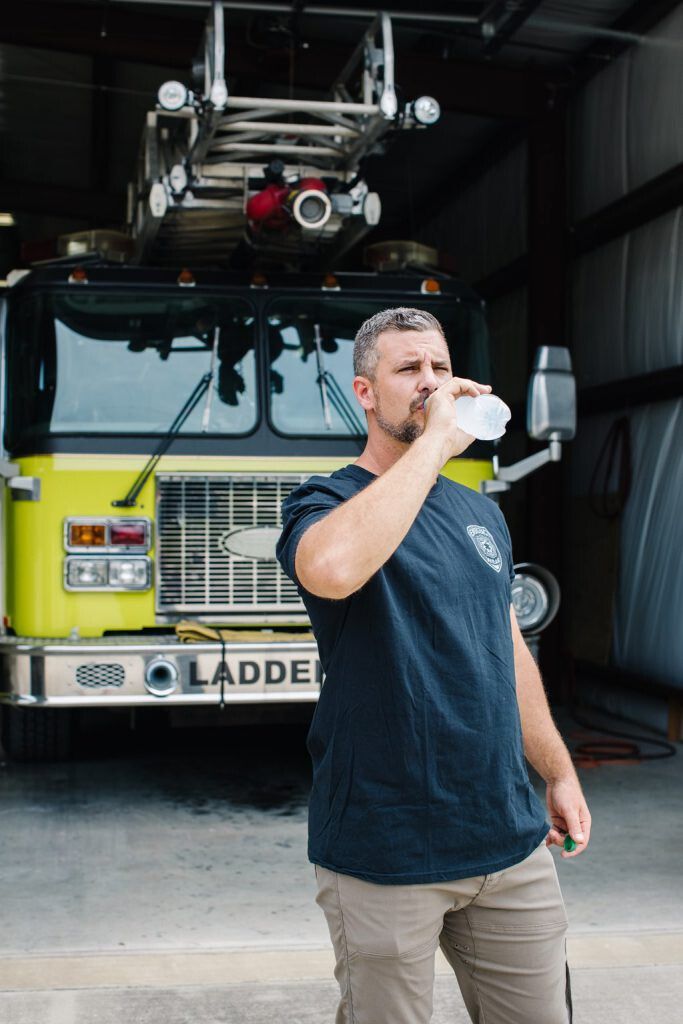

These photos from Kent Precision Foods Group depict workers from various industries (auto mechanic, firefighter, construction worker) hydrating. Workers lose salt and other electrolytes when they sweat. Substantial loss of electrolytes can cause muscle cramps and other dangerous health problems. Water cannot replace electrolytes; other types of beverages, such as electrolyte-containing beverages are sometimes needed. Water or other fluids provided by the employer should be cool and stationed in a location that is familiar to the workers, near the worksite, easy to access, and in sufficient quantity for the duration of the work.

The best way to prevent heat-related illness is to make the work environment cooler. The photo from Lake Havasu City in Arizona depicts a mechanic working on a vehicle on a hot day. The fan provides relief by increasing the air flow.




The photos from McWane Ductile depict some of the initiatives in their heat stress program. The stoplight image shows how the company asseses their heat stress days, where the yellow and red lights mean different procedures are followed to keep workers safe. For example, when the yellow light is on, workers are on a 45 minutes on, and 15 minutes off schedule. When the red light is on, workers do a 30 minutes on and 30 minutes off schedule. Through their heat safety program, the company trains their crew on heat illness prevention. The photos also depict different controls the company has implemented, such as the roofed break area to provide shade to workers outdoors, as well as the cool booths that are equipped with air-conditioning and a water dispenser year-round.



The photos from MDX depict workers taking a break and consuming water and electrolyte-containing beverages. The crew is using an adjustable canopy structure to maximize shade coverage, and they have access to a portable fan.

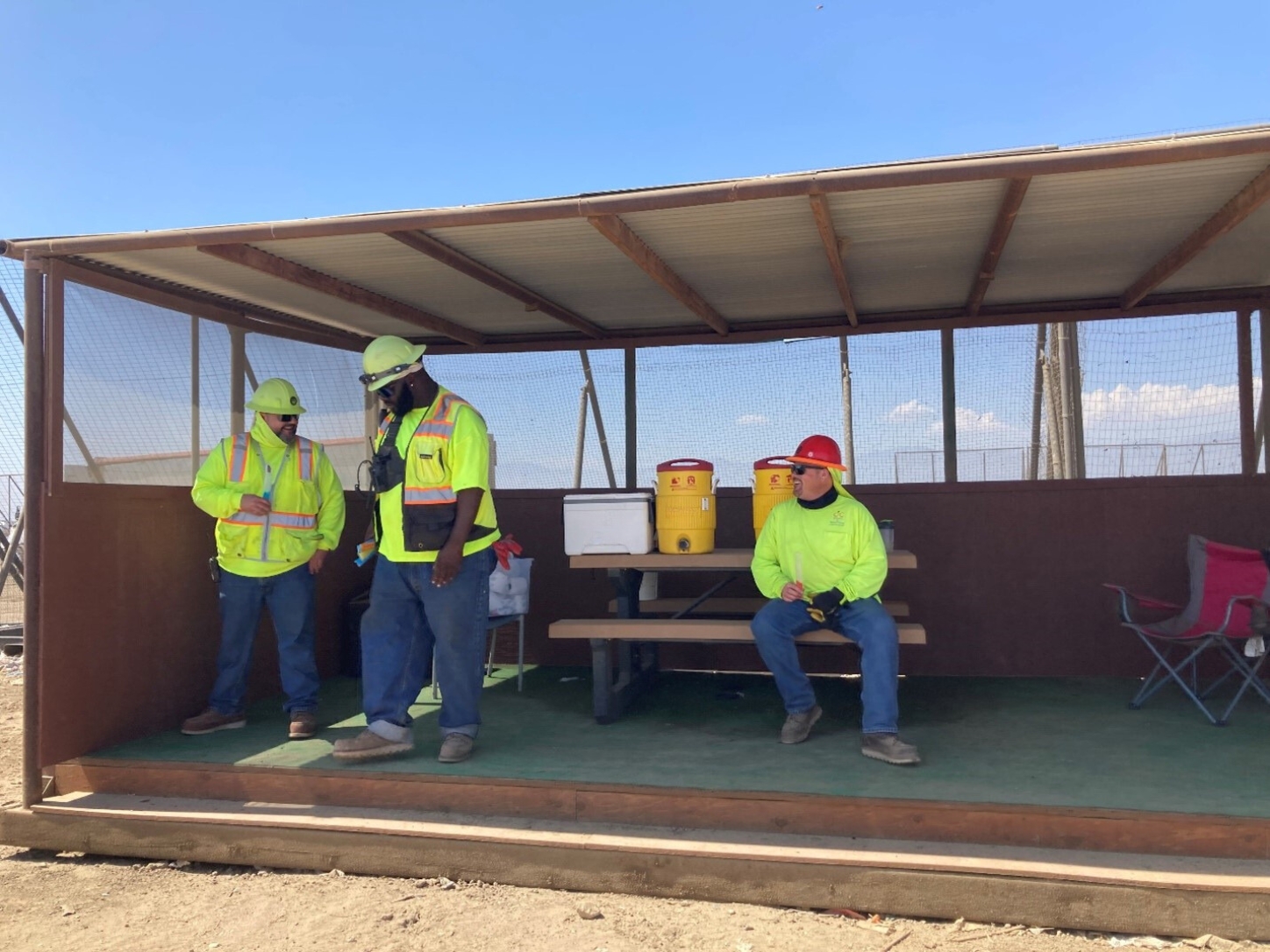

These photos are from the Orange County Waste & Recycling Olinda Alpha Landfill. In the photos, an employee directs commercial disposal trucks to their designated areas. To ensure comfort and safety, the employee is equipped with a shaded spotter stand, a highchair, and a battery-operated misting fan. Fresh water is provided daily and continuously replenished as needed, helping the employee remain hydrated and comfortable in the high heat. Additionally, the employee wears high visibility gear to remain clearly seen by customers, showcasing the commitment to safety and heat management in extreme conditions. The photos also depict employees take a well-deserved break in a shade structure after long hours of working under the sun. The workers stay hydrated with water, electrolyte-containing beverages, and freeze pops, which help them remain refreshed and safe while in the heat.
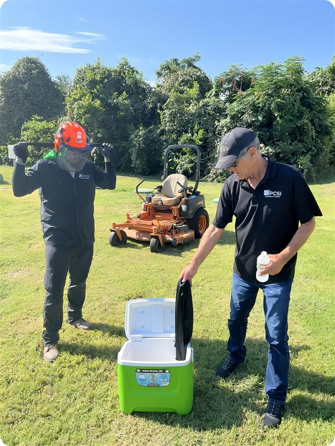

These photos from Professional Contract Services show important controls to combat the effects of high heat. In one image, workers are adding cooling towels to ice-cold water and then putting the towels around their necks to help cool their bodies. In the other photo, vehicle maintenance mechanics are using evaporative cooling fans to ensure they are staying cool while inside.
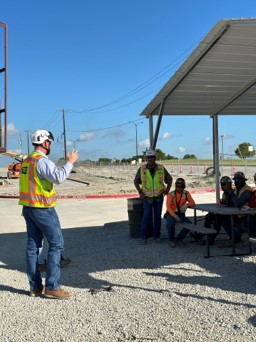

The photos from Rogers-O’Brien Construction show their onsite cooling stations for rest and recovery. These areas provide a shaded place to sit where employees can refuel, rest, and recover during breaks. The large fan in back provides ventilation with a misting effect. The other photo showcases a safety briefing for heat illness prevention. These stand-down activities equip employees and trade partners on site with the knowledge to prevent heat illness, such as how to stay hydrated, taking breaks in shaded areas, recognizing early signs of heat stress, and responding appropriately if someone experiences symptoms.
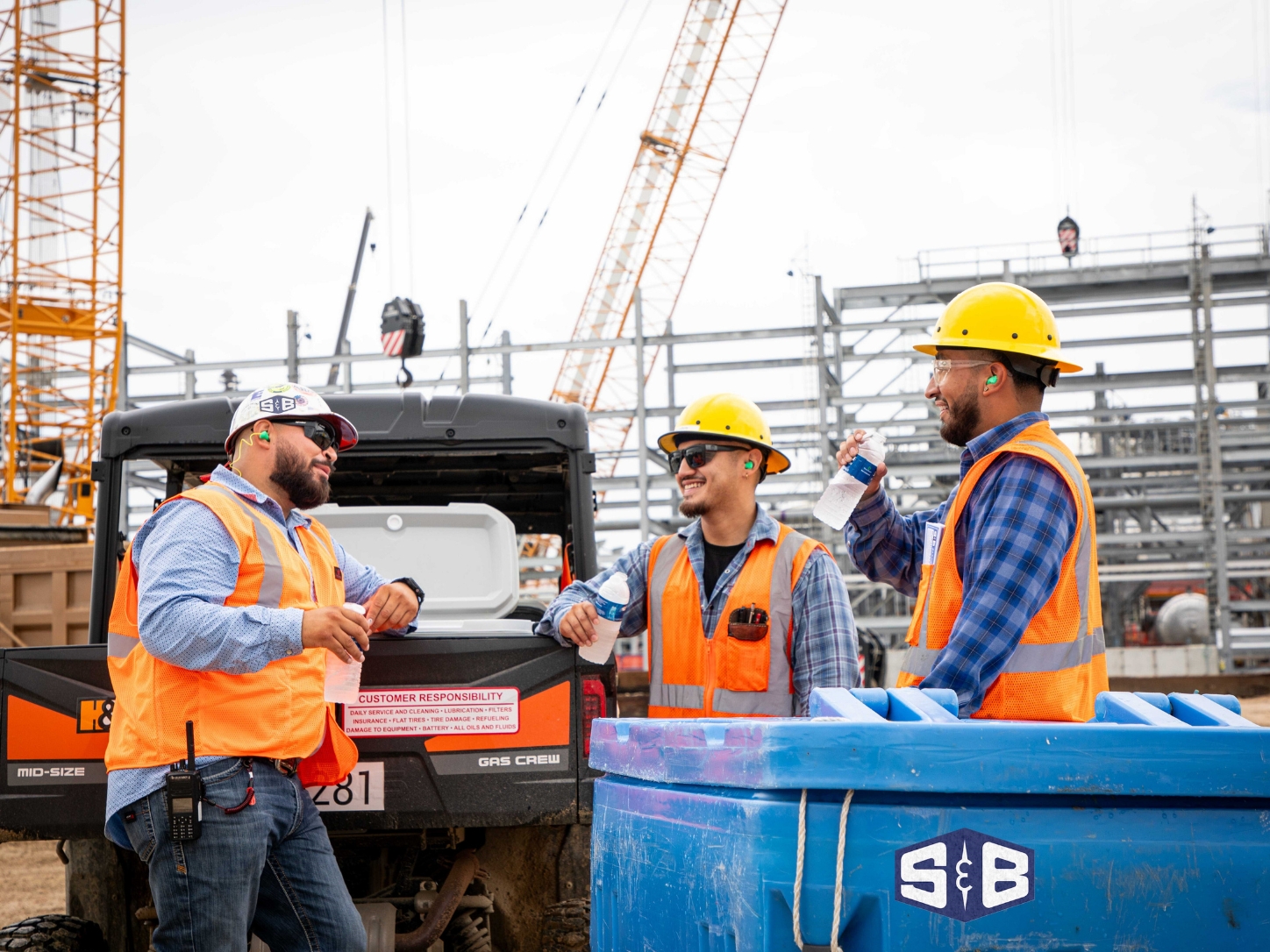

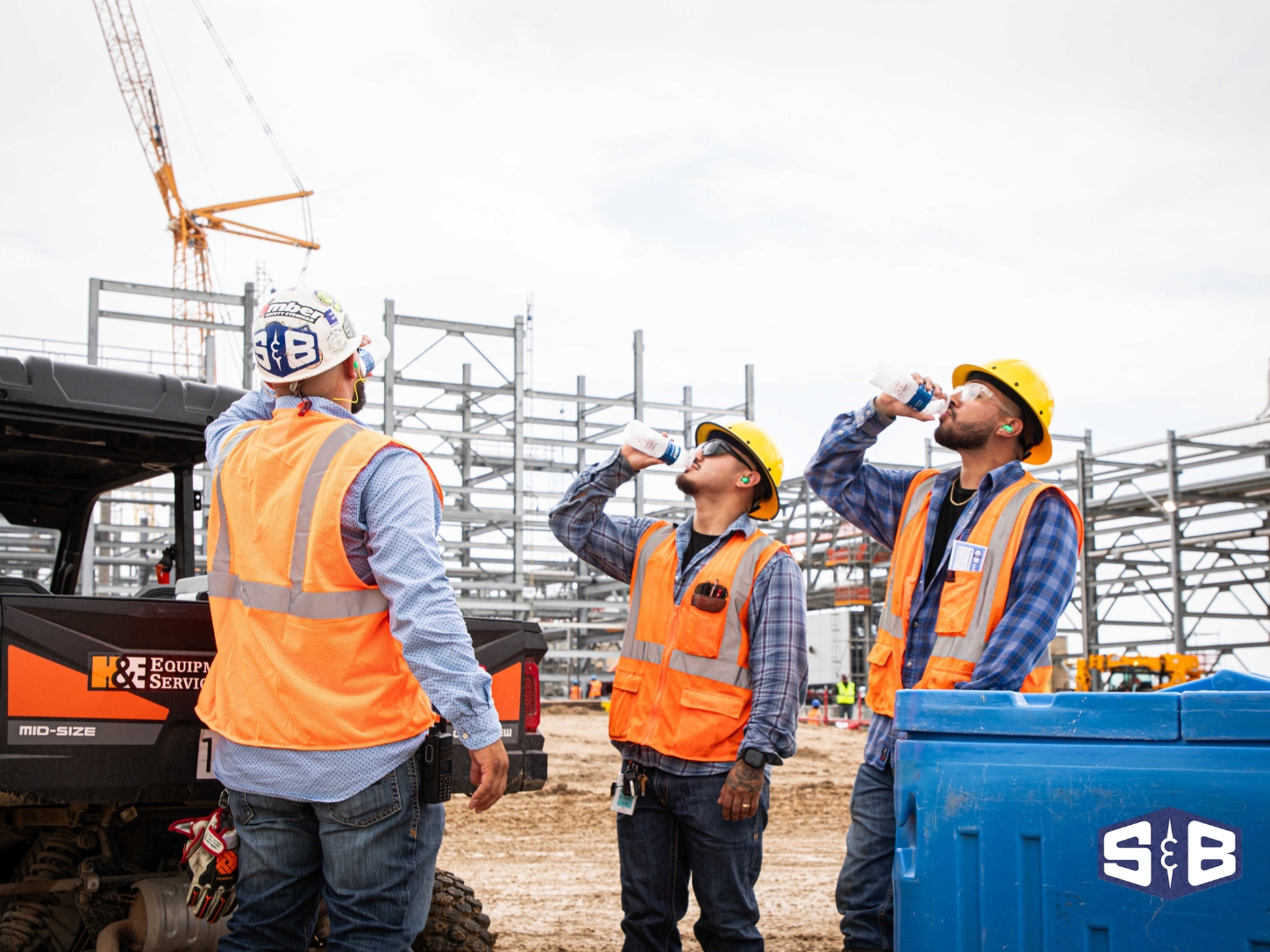
The photos from S&B Engineers and Constructors depict a safety specialist passing out hydration packs to workers. The water cooler is on the back of a company utility vehicle. These vehicles can be used to drive around large outdoor worksites and bring water to workers who might need a refill. In one of the pictures, a worker is completing their hydration log. A hydration log can help workers keep track of their water intake and serve as a reminder to make sure they are properly hydrated. Workers should be encouraged to drink at least one cup (8 ounces) of water every 20 minutes while working in the heat—not just if they are thirsty.

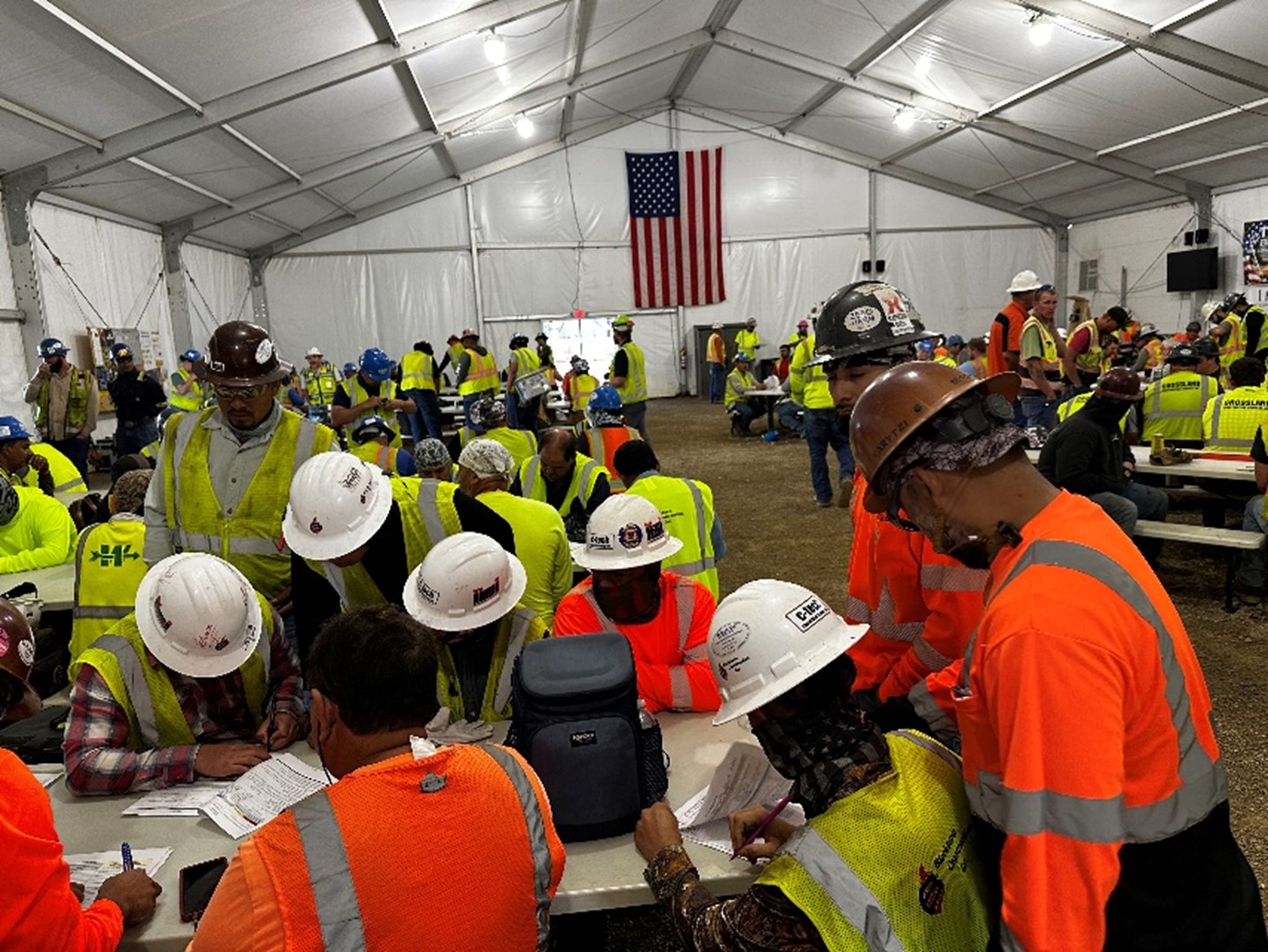
One photo from Savage Co depicts a crew of workers taking a break in the company’s cool down station. These cool down stations are mobile air-conditioned stations that can be moved to maximize use and proximity to work locations. The other photo shows a larger group of workers taking a break in Savage Co’s large, air-conditioned tents. These tents are provided for relief from the heat.

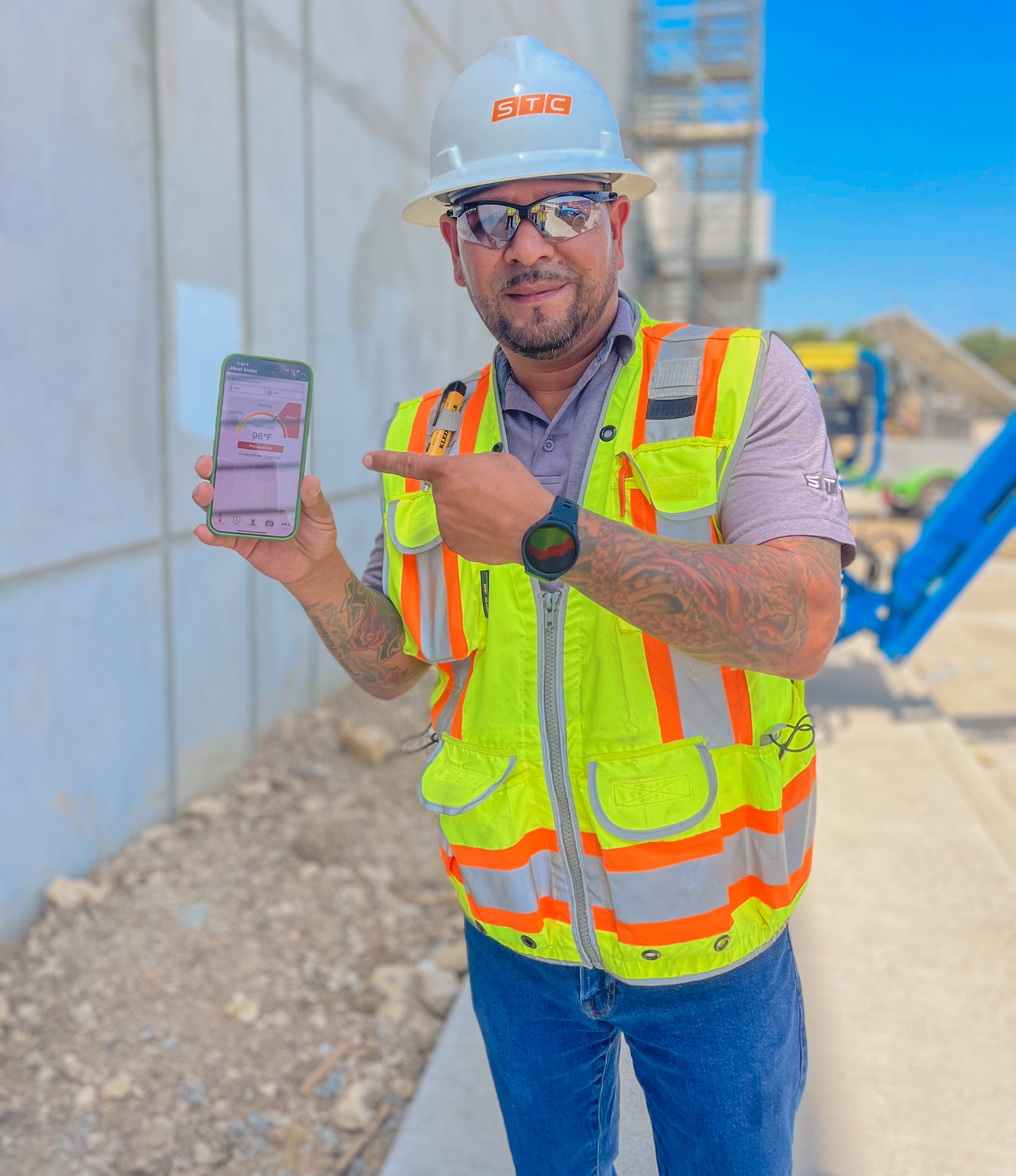
In these photos from Safety Training & Compliance, LLC, a field manager is using the OSHA-NIOSH Heat Safety Tool app to stay aware of high heat temperatures while on a job site. He used this information to inform the crew he was visiting of the hot weather conditions and reminded them to stay hydrated and to take breaks in the shade. In the other image, workers attended a heat safety training to learn how to stay safe in the heat. Workers are learning about various topics, such as using urine color to check their hydration status.

The photo from Sunland Asphalt & Construction depicts workers taking a water break in the shade. Pop-up canopies, or other artificial shade structures, can provide relief from direct sun exposure when other sources of shade are not available nearby. When a canopy or similar shade structure are used, it’s important to make sure that the structure is large enough that all workers are in the shade. If needed, employers should consider using an additional canopy to ensure appropriate shade for all workers.
In the photo, Superior Tube Products (STP) first responders and managers are undergoing a heat illness prevention training. This was an important refresher in what symptoms to look for, the different stages of heat illness, and what to do when you recognize that someone has these symptoms. During this training the employees were given OSHA's Prevent Heat Illness at Work information as a pocket guide. STP rented chilled water and placed chillers throughout the facility to ensure that all employees had access to cold water and provided all employees with reusable water bottles.
Contest Description and Rules
Contest participants were allowed to submit a maximum of 5 photographs. The requirements for the submissions included that the photos:
-
Must promote heat safety in the workplace.
-
Must be original creations, not copied from OSHA.gov or any other source, and under the submitter's ownership and control. Contestant is responsible for getting authorization from the people captured in the photo to use and submit their image in OSHA's contest and for OSHA's use. See Written Consent from Personal Identifiable Information under Terms and Conditions below.
-
Photographs must not depict a violation of an OSHA standard, uncontrolled hazard, or any unsafe procedure or practice.
-
Photographs must not endorse or be perceived to endorse a commercial product or service. This includes but is not limited to the display of brand names or trademarks on any people, equipment, or other objects visible in the photograph. Note: OSHA reserves the right to alter any submitted image by blurring identifying brand names, trademarks and other third-party intellectual property.
-
Must submit web form.
-
Entries must be in one of the following formats (weblink, JPG, PNG, Word, PPT).
-
Contestants must acknowledge contest rules and provide contact information.
The entries submitted for this Occupational Safety and Health Administration (OSHA), U.S. Department of Labor (USDOL) Beat the Heat Photo Contest do not necessarily reflect the views or policies of the USDOL, nor does the mention of trade names, commercial products, or organizations imply endorsement by the U.S. Government or OSHA.
OSHA encouraged submissions from any industry, such as, general industry, construction, agriculture, retail, warehousing, hospitality, etc. As such, a contest "participant" included private citizens, individual businesses, associations, trade groups, worker centers, unions, non-profit organizations, educational institutions, research groups, state and local government entities, among others.
All contest submissions agreed to the contest terms and conditions outlined below.
Intellectual Property
- Winning submissions will be posted on OSHA's website and announced in Summer 2024.
- Submissions and winners' names may be used by OSHA (e.g., on OSHA social media accounts, webpages and at events) in connection with this contest and the production, distribution, promotion, broadcast at public meetings/conferences, and online posting thereof.
- Each submission must comply with federal copyright and trademark law. All of the content in a submission must be the original work of the submitter. The Participant warrants and represents that they are the sole owner of the photographs and have the permission to share the image of the people portrayed in the photographs and to capture the image and location depicted in the photograph submitted for this contest and/or that they have the legal right to share the submitted work with OSHA and grants OSHA and the U.S. Department of Labor (USDOL) non-exclusive, unlimited, irrevocable, world-wide, and royalty-free rights to use, namely, to copy, modify, distribute, and publicly display and perform their submission for Government uses and purposes. In addition, the Participant warrants and represents that they are the sole owner of any trademark incorporated or included with their submitted work. As such, the Participant grants OSHA and USDOL a non-exclusive, unlimited, irrevocable, world-wide, and royalty-free license to use such trademark/s for Government uses and purposes.
Written Consent from Personal Identifiable Information
For any submission that contains the name, written statement, and/or photographic image of any identifiable person, the Participant represents and warrants that they have obtained the written permission of that person to use their name, written statement, and or recorded image for the purpose of this contest.
Participants should seek legal guidance if they have questions about using copyrighted, trademarked, or personal identifiable materials in contest submissions.
OSHA reserves the right to alter any submitted image by blurring identifying brand names, trademarks and other third-party intellectual property.
Assumption of Risk, Liability, Indemnity
The Participant agrees to assume any and all risks and waive claims against OSHA, USDOL, the Federal Government and its related entities, except in the case of willful misconduct, for any injury, death, damage, or loss of property, revenue, or profits, whether direct, indirect, or consequential, arising from their participation in a prize competition, whether the injury, death, damage, or loss arises through negligence or otherwise.
To the extent permissible under federal law, Participant shall indemnify, defend, and hold OSHA, USDOL, the Federal Government, and its agents harmless from and against any and all suits, claims, liabilities, demands, costs, expenses, or damages arising out of submitter's use of the works as provided herein or arising out of the breach of warranty or agreement made by submitter herein.
Non-Endorsement
OSHA and OSHA officials do not endorse any product, service, or enterprise that may appear in submission materials. Furthermore, by recognizing winning submissions, OSHA is not endorsing any products, services, or enterprises that may appear in those submissions.
The submissions and contest winners do not necessarily reflect the views or policies of the U.S. Department of Labor or OSHA and reliance on the tools or guidance noted in any submission is not necessarily sufficient to satisfy an employer's obligations under the Occupational Safety and Health Act. The submissions are not standards or regulations and create no new legal obligations. Employers should consult OSHA guidance on occupational heat on its heat webpage, particularly its page on employer responsibilities. Additionally, the mention of trade names, commercial products, or organizations in any submission does not imply endorsement by the U.S. Government or OSHA.
OSHA has existing resources on hazardous heat at osha.gov/heat
If you have any questions about the contest, please contact heatcampaign@dol.gov


